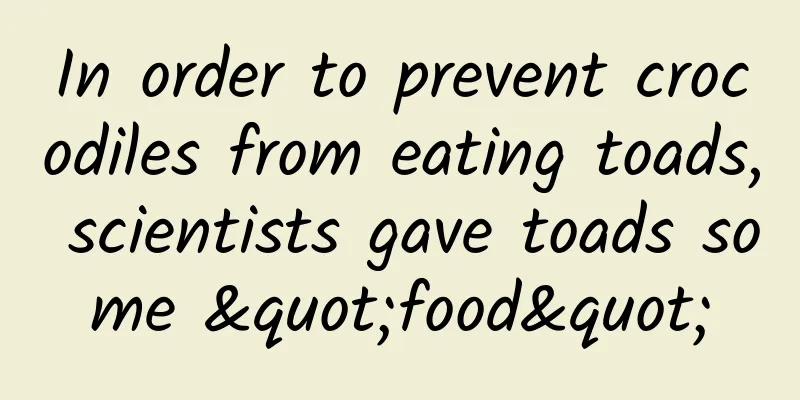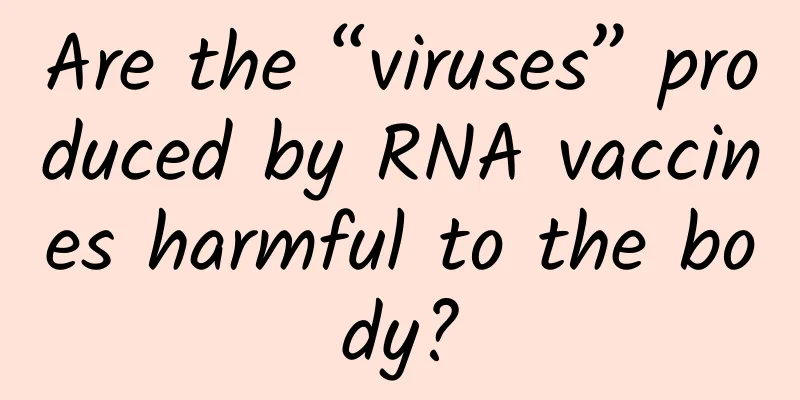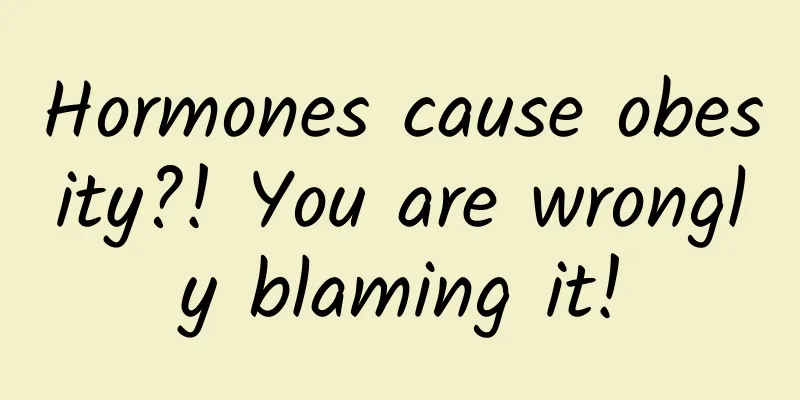In order to prevent crocodiles from eating toads, scientists gave toads some "food"

|
Produced by: Science Popularization China Author: Su Chengyu (popular science creator) Producer: China Science Expo Editor's note: In order to decode the latest mysteries of life science, the China Science Popularization Frontier Science Project has launched a series of articles called "New Knowledge of Life" to interpret life phenomena and reveal biological mysteries from a unique perspective. Let us delve into the world of life and explore infinite possibilities. At dusk, the crocodiles lurking in the Leonard River popped their heads out and drooled over the dead toad hanging on the metal boom. Little did they know that this was a bait deliberately set by scientists. And this was a toad with added ingredients, salty. This was not just a normal salty "seasoning", it was a "seasoning" that could make the crocodiles sick. "Bait" (Image source: Reference 1) Why do scientists do this? What's the point? It all started more than 80 years ago. In 1935, 102 cane toads were introduced from Hawaii to the sugarcane growing areas of Queensland and released into the sugarcane fields. The original intention of introducing the toads was to use them to prey on the larvae and adults of the sugarcane beetle. toad (Image source: Wikipedia) Cane toads quickly multiplied and spread in their new environment. They adapted to the Australian climate and environment and began to quickly occupy new habitats. With no natural enemies or competitors, the number of these toads increased rapidly. The pests they were trying to control were not affected at all. This is because cane toads mainly move on the ground, while these pests live underground. However, cane toads pose a significant threat to Australia's native invertebrates, amphibians, reptiles and small mammals. They compete for food resources and prey on many native species. The most serious problem is that cane toads contain toxins in their skin and glands that are lethal to many native Australian predators. In the 1990s, the cane toad's range gradually extended northward, close to the border between the Northern Territory and Western Australia. In the early 2000s, cane toads began to invade the river system of northern Australia in large numbers, and the first incidents of poisoning and death from eating cane toads appeared in crocodile habitats. At this time, the mortality rate of freshwater crocodile populations began to rise. Crocodile carcasses with their stomachs turned upside down were often found floating on the surface of the river. Crocodile carcass (Image source: ABC) (Image source: Reference 2) After dissecting the crocodiles, scientists found that their stomachs still contained the remains of their last meal: toad meat. The toad toxin works by affecting the animal's heart and nervous system, causing cardiac arrest or neurological disorders. Why do crocodiles eat poisonous food? Because this toxin is not like irritants such as capsaicin, which will cause strong discomfort or pain immediately after entering the mouth, so crocodiles generally do not have any taboos. Crocodiles usually attack and devour their prey quickly, rarely chewing or judging the texture and taste of their prey before taking it in. Crocodiles mistake the slow, seemingly harmless cane toad for a common frog or other non-venomous amphibian, so they devour it quickly. (Photo credit: Mike Letnic) Taste aversion training In order to reduce the death of crocodiles and prevent them from eating poisonous toads, scientists came up with a solution: add food to the toads to make them unpalatable. This experiment is professionally known as Conditioned Taste Aversion Training (CTA), a learning method based on classical conditioning, which is used to make animals develop aversion to certain foods by experiencing unpleasant physical reactions (such as nausea and vomiting) after eating them, thereby avoiding eating such foods again in the future. Starting in 2021, scientists began a three-year study in the Kimberley region of northwestern Australia, where the largest freshwater predator in northern Australia is located: the Australian freshwater crocodile (Crocodylus johnstoni). The research team deployed 2,395 bait points in four canyon systems in northwestern Australia. At each bait point, two metal stakes were set up and bait was hung between the stakes. There were two types of bait, one was the experimental group, which was the treated toad carcasses. These toads were detoxified and injected with 5 ml of 0.5 molar lithium chloride (LiCl). The other metal pole was hung with chicken necks. Alligator taking bait (Image source: Reference 1) Chicken necks were used as a non-treated bait to help the researchers determine if the alligators' aversion response was specific to cane toads. If the alligators did not show an aversion response to chicken necks but only to cane toads, this would indicate that the CTA training was successful and that the alligators' aversion response was specific to cane toads, rather than a general response to all foods. Lithium chloride was chosen as the "seasoning" because it is not only salty, but it can also produce a nauseating reaction. When ingested by animals, lithium chloride can cause gastrointestinal discomfort, which in turn can lead to nausea and vomiting. Although the specific mechanism may vary from species to species, it is generally related to its metabolism in the body and its effects on the central nervous system. Lithium chloride was briefly used as a substitute for table salt (sodium chloride, NaCl) in history. After World War II, as the link between high-sodium diets and high blood pressure became known, scientists began looking for low-sodium alternatives to help control salt intake. Lithium chloride was considered a possible substitute at the time because it is similar to sodium chloride in chemical structure and taste, with a salty taste. Lithium chloride crystals (Image source: Wikipedia) In the late 1940s, lithium chloride was used in some low-sodium salt products, mainly for patients with high blood pressure and those who needed a low-sodium diet. However, the use of lithium chloride soon showed serious side effects, that is, gastrointestinal discomfort symptoms such as nausea, vomiting, and diarrhea may occur. Due to the toxicity of lithium chloride, the products were quickly removed from shelves, and the use of lithium chloride as a salt substitute was discontinued in the early 1950s. Although lithium chloride is no longer used in food, it still plays a role in medicine and animal experiments, such as CTA training in research. After CTA training, especially in the short term, the effect is particularly obvious. The food intake rate on the first day was 92%, which dropped to 51% on the fifth day. Throughout the experimental period, the number of crocodiles remained stable, with no large-scale deaths. For example, in one national park, the mortality rate of crocodiles in the area was 33% and 30% in the first two years after the invasion of cane toads (2019 and 2020), respectively. After the implementation of CTA training (2021), the mortality rate dropped sharply to 1.5%, and then rose to 11% in 2022. In the control areas that were not treated with CTA, the mortality rate of crocodiles increased significantly. In 2020, 2021, and 2022, the mortality rate of crocodiles in these areas was 20%, 40%, and 36%, respectively. In short, feeding cane toads is a useful method, and no crocodile likes to eat food that makes it disgusting. Crocodile (Image source: rainforest) However, CTA training may not be a long-term strategy. Although CTA can effectively make animals avoid specific foods in the short term, it remains a question whether this aversive response can persist in the long term. Studies have shown that in some cases, animals may gradually resume feeding behaviors towards aversive foods over time, especially when other food sources are lacking. For example, also in Australia, researchers used CTA to train northern martens to avoid eating poisonous cane toads. While initial training was successful and the martens were able to avoid eating cane toads, over time, some martens' aversion responses weakened, especially in areas where cane toads were widespread. When food became scarce, the martens might risk trying to eat cane toads again, causing the training effect to wane. Therefore, it is really difficult to engrave the memory of hating toads in the bones (genes), and it may not be solved by two or three years of experiments. References: [1]Ward-Fear G, Bruny M, Rangers B, et al. Taste aversion training can educate free-ranging crocodiles against toxic invaders[J]. Proceedings of the Royal Society B, 2024, 291(2028): 20232507. [2]Snijders L, Thierij NM, Appleby R, et al. Conditioned taste aversion as a tool for mitigating human-wildlife conflicts[J]. Frontiers in Conservation Science, 2021, 2: 744704. [3]HANLON LW, ROMAINE M, GILROY FJ, et al. Lithium chloride as a substitute for sodium chloride in the diet: Observations on its toxicity[J]. Journal of the American Medical Association, 1949, 139(11): 688-692. |
>>: How to get the flu vaccine this year? All your questions are here
Recommend
(Big Soldier Data Flow Operation) Dou+ Doujia Practical Tutorial
(Big Soldier Data Flow Operation) Dou+ Doujia Pra...
Summary of special events in major Android markets in March (registration in progress)
Millet [March traffic event] Registration is open...
Baotou SEO Training: How to quickly improve website inclusion and weight?
How to increase website entry? 1.URL submission T...
"Zu Chongzhi" is online! China's 176-bit quantum computing cloud platform is open to the world
Xinhua News Agency, Hefei, May 31 (Reporters Xu H...
Go to Deyang and see the hardcore Sichuan
I hope the high temperature and power shortage wi...
How to write a good article title?
The author of the public account Caobian Wangshi,...
It’s such a pity that 90% of the creative information flow logos are placed in the wrong place!
"Make the logo bigger! Bigger!" - Proba...
Apple plans to release a new MacBook Air this year with USB 3.1 interface
In the early morning of January 7th, Beijing time...
Home appliance sales are "one-sided": online sales are booming, while offline sales are bleak
The home appliance market has been declining sinc...
Why did life evolve the function of death?
Survival or destruction? This is not only a philo...
How to get the new version of AppStore traffic bonus before iOS11 is released
Introduction: For APP promotion and operation per...
BAT enters the film and television industry and the industry war is about to break out
Just as Alibaba invested 2.4 billion in Guangguan...
A heart-breaking question for holiday travel: Why is the signal on the high-speed rail so poor?
High-speed rail is an important symbol of the mod...
Coupon Operation Guide: One coupon to attract new customers, promote activation, conversion, and recall
Coupons can play a good role in attracting new an...
2019 Kuaishou operation tips for increasing followers!
The predecessor of Kuaishou, called "GIF Kua...









